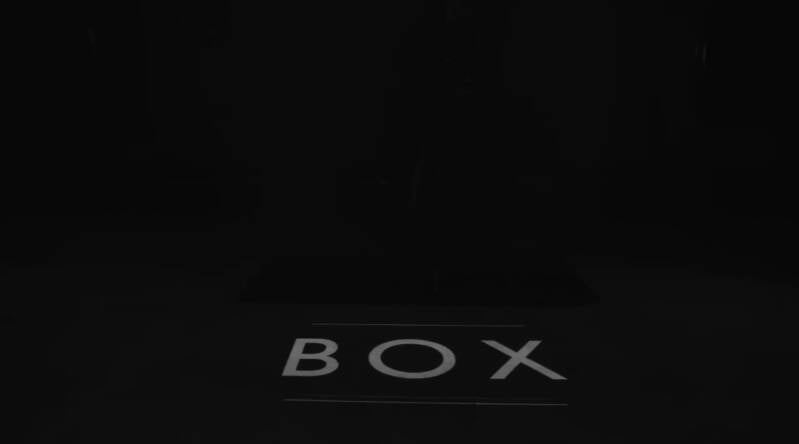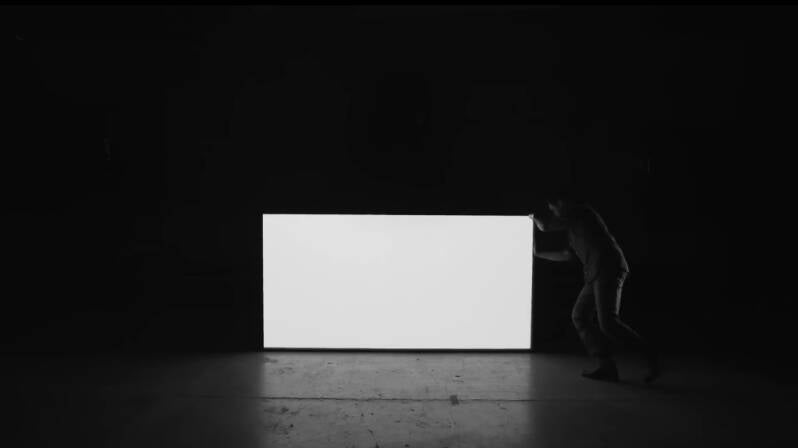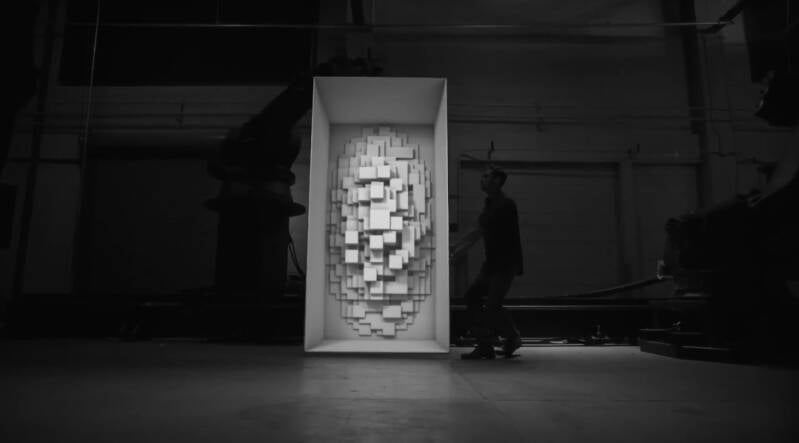Soundcape of Innovation: Interpreting the Visual Aesthetics of Bot and Dollys Box through Sound
Programme Note

Introduction
This programme note explores an individuals interpretation of Bot and Dollys ‘Box’, translating its visuals into an immersive soundscape.
This electronic composition is a sonic reinterpretation of Box, the groundbreaking performance by Bot & Dolly that seamlessly fuses robotic precision, projection mapping, and choreography. Reflecting the stark black-and-white aesthetic and the clean, geometric precision of its visuals, this score embraces a minimalistic electronic approach. With the inclusion of a sampled Kalimba to accompany the box and its movements, complementing its brightness within an otherwise anticipatory and mysterious theme. Each chapter of the piece is based on 5 principles of magic and with the music stripped to its core elements, (textures, pulses, and spatial dynamics) it reflects the calculated movements and modern camera techniques that define 'Box'. Crash cymbal reverb tails are strategically employed to smoothen transitions allowing shifts in momentum to feel fluid and with an essentialist approach to sound design, the composition draws full focus to its electronic structure, meticulously crafted to capture the essence of the demonstration.

Chapter 1: Inception
Inception, a restrained yet anticipatory opening, sets the stage for a world where perception is fluid. The composition begins with footsteps, subtly reverberated to match the visuals, adding an organic element that grounds the otherwise electronic soundscape. Rooted in a D whole-tone scale, the composition follows a bassline with a chord progression of D, E, F♯, E, reinforcing its sense of fluidity and ambiguity. A sampled Kalimba is introduced as a recurring box motif, its delicate, percussive timbre accentuating the film’s visual aesthetic while mirroring the shifting movements within the Box. Its natural resonance adds warmth to the composition, subtly contrasting the stark precision of the digital elements and enhancing the film’s themes of transformation and illusion. Additionally, a synthesized alarm bell played in reverse with a spacious reverb plays on transition to the next chapter and remains consistently on every third bar throughout the entire track, enhancing the anticipation for the coming chapters.

Chapter 2: Tranformation
Evolving patterns and shifting textures echo the Box’s morphing form, its minimalism reinforcing the interplay of light and shadow. Following Inception, the first official movement of the musical piece introduces a rhythmic pad created using an Ableton Live wavetable synthesizer. Processed with an automated tremolo, this pad enhances the eerie atmosphere, intensifying at key moments of Transformation. To add depth and variation, a duplicate of the same instrument plays only the C notes an octave higher than the primary track. Alongside this, a sampled kalimba in Ableton is introduced, its delicate plucked tones mirroring the ripples and shifting movements within Box, reinforcing the sense of fluid motion. This section opens with a restrained yet anticipatory mood, setting the stage for a world where perception is fluid and reality is questioned. The subtle modulation builds tension and seamlessly guides the composition toward the next chapter, Levitation.

Chapter 3: Levitation
Sparse yet expansive, the Levitation section conveys weightlessness, mirroring the illusion of gravity-defying motion. This chapter embodies my interpretation of Box’s visuals—where rigid structures give way to fluidity, and objects seemingly break free from the constraints of gravity. Following Transformation, this chapter introduces atmospheric pads, crafted through extensive experimentation with Ableton Live’s new synthesizer, "Meld". These textures create an ethereal foundation, evoking the sensation of floating in an undefined space. Midway through, a second layer emerges, playing the same chords an octave higher, subtly reinforcing the feeling of upward motion. Complementing this airy backdrop, a steady rhythmic drum beat emerges, centered around a deep, pulsing kick drum. Its presence is subtle yet grounding, anchoring the composition while reinforcing the contrast between weightlessness and structure. The layering of all these sounds together enhances the overall perception of depth, as if the music itself is rising alongside the visuals. The sampled kalimba returns, its presence shaped by precise volume automation, seamlessly blending in and out to align with key visual moments. Just as the spherical forms shift and ascend, the kalimba weaves in and out of focus, mirroring their fluid movement. This dynamic control reinforces the adaptability of these forms, emphasizing their continuous, effortless motion toward the void in the upper level. The chapter culminates in a drastic and dramatic decrease in tempo, almost as if time itself is stretching, slowing the ascent into a moment of weightlessness. This transition naturally guides the composition into the breakdown of the next chapter, Intersection.

Chapter 4: Intersection
The convergence of pulses and fragmented rhythms in this chapter reflects the seamless fusion of digital precision and human expression. At the heart of this movement, a lead pad synthesizer introduces a melody that weaves through the rhythmic complexity, adding a sense of fluidity to the structured motion. The bassline, now simplified with a shorter decay, delivers a sharper, more percussive presence, giving it a distinct kick that locks in tightly with the drum track. Throughout the midway point of Intersection, the sampled kalimba provides a consistent pulse, acting as a rhythmic anchor amidst the evolving textures. This steady presence reinforces the sense of motion, allowing the composition to bridge the gap between mechanical control and organic movement. As the section progresses, the tempo is automated on a deep slope, gradually accelerating to build momentum, seamlessly carrying the piece into the next chapter, Transportation.

Chapter 5: Transportation
Audio bursts and manipulation of spatial dynamics evoke the sensation of instant displacement and rapid perspective shifts. Transportation begins with the sampled kalimba box motif, its rhythmic pattern establishing a sense of continuity while subtly evolving in response to the shifting environment. Layered beneath it, a kick drum—processed with a subtle reverb—adds depth and movement, reflecting the dynamic, unpredictable trajectory of the Orb within the Box. A simple synthesized pad lingers in the background, subtly enhancing the atmospheric quality of the visuals, reinforcing the sense of spatial expansion. The interplay between these elements creates a sensation of fluid motion, as if sound itself is being transported through shifting dimensions. As the chapter progresses, momentum builds, textures expand, and rhythmic patterns intensify, leading seamlessly into the transition to the final chapter, Escape.

Chapter 6: Escape
A final release, where structure dissolves into an open-ended sonic space, leaving behind a sense of boundless freedom until ultimately the track ends and you are brought back to the realization that you are watching the movements of cameras instead of visual effects. At the climax of the composition, all previously introduced elements converge, amplifying the intensity of the situation. The drums build toward the final note, mirroring the escalating tension within the box, before abruptly cutting off, bringing the piece to a sudden and dramatic conclusion. As the soundtrack fades into the darkness, the minimalistic sound design resurfaces, as if it has always been there, subtly grounding the moment.
Final Product
Click the button below to be directed to the completed project on my YouTube channel. I hope you enjoy!